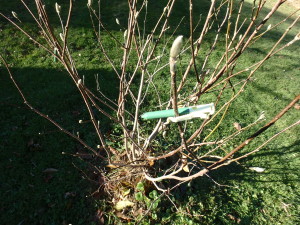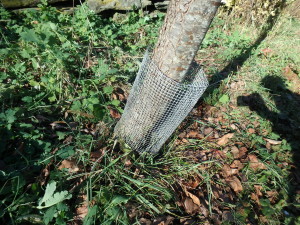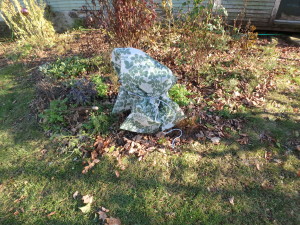Getting Trees and Shrubs Ready for Winter
All right, I’ve managed to clean up my vegetable gardens and rake the lawn. I’ve gotten most of my flower beds cut back, weeded, and raked. So can I relax and watch football? NO, not yet. Smug though I may be for doing all that, there is still work to do. Trees and shrubs need attention now.
Let’s start with the deer. You know what trees and shrubs deer will eat. What can we do to protect those tasty treats? I’ve had good luck with a garlic repellent, one called, “Deer and Rabbit Repellent” made by Plant Pro-Tec. These are little cylinders (3 inches by half an inch) with a clothes pin type attachment that can clip onto branches.
Each package of 25 comes with a small tool to puncture the garlic oil storage compartments when you are ready to use them. They are rated for use by organic gardeners, and relatively inexpensive. I’ve used them on shrubs previously eaten by deer, and never lost a bud. They should be available at your local garden center or on-line at www.plantprotec.com.
Voles can be lethal to young fruit trees. Two years ago we had very deep snow and many gardeners lost fruit trees to voles – they girdled the trees, chewing off the bark and cambium layer, which eventually killed the trees. The deep snow allowed the voles to stay hidden from owls and hawks, allowing them to greatly increase in number.
To prevent that from happening, you can physically keep the voles away with fine-mesh screening called quarter-inch hardware cloth. It comes in 18- and 24-inch rolls, and I recommend the wider roll. A single layer of mesh screen around the base of the tree will keep the voles a bay. Remove the wire next spring to keep it from getting swallowed up by the bark as the tree grows (that would take a few years, but I’ve seen it happen).
Also available are plastic tubes slit up the side, allowing you to open the slit and slide the tube around young trees to protect them from rodents. These are generally 2 inches in diameter and 24 inches long. If your young tree has branches in its lower 2 feet of trunk, you will have to prune off those lower branches. But that is good anyway. And voles shouldn’t bother trees that are more than 2 inches in diameter anyway – their bark is thick enough to deter the rodents.
What about tender young shrubs? Will they survive the winter and bloom in the spring? Some gardeners like to wrap shrubs in burlap to protect them from cold winter winds. The winds can desiccate buds, preventing them from blooming. In 2015 I planted a kousa dogwood which is marginally hardy here. Last spring I only got a couple of blossoms – even though there had been more buds.
So this fall I wrapped my dogwood with a synthetic fabric designed to keep the cold wind from damaging buds, but allowing it to breathe. The material came in 12-foot by 5-foot pieces, and was sold as a “Bush Jacket”. I was given some of this material some years ago and hadn’t used it. An internet search told me that Gardener’s Supply is one source for it, and they don’t have it as sheets, but as bags or “jackets” that fit over small, medium or large shrubs.
An advantage of wrapping shrubs with either non-woven polypropylene fabric or burlap is that will also keep deer from eating your shrubs.
On a nice sunny Sunday I worked on my blueberries, too. I weeded them, digging up the sod that had grown right up to the base of each plant. I created a space free of grass and weeds about 18 to 24 inches all around the bushes. Blueberries have fine roots near the surface, so I was careful not to dig deeply with my weeding tool. I found that once I got started I could peel back the sod in big pieces with my hands. I will sprinkle some agricultural sulfur over the soil, and then put down a 3-inch layer of ground branches I got from an arborist.
The sulfur helps to keep the soil pH very acidic, which will promote good fruit production. Next year’s fruit buds are already set, so applying sulfur this year will not affect next year’s production. But in following years the sulfur will be a big help.
My apple trees did not produce much this year – there was a hard frost in April when the buds were getting ready to open. Additionally, the year before had been extraordinarily fruit-productive and trees tend to alternate between good years and bad. But this fall the fruit spurs are loaded with flower buds for next spring.
I picked or cut off any dead fruit still attached to the trees. Often diseased fruit will dry up and stay on the tree, and I don’t want any fungal spores to infect next year’s crop. I used a pole pruner to cut or knock off dead fruit. Finally, I raked under the trees to collect rotten fruit or infected leaves. I put all that on my burn pile that is awaiting snow for an opportunity to burn it.
You could also prune your fruit trees now, or in the late winter or early spring. But that’s an article for another day.
Read Henry’s twice-weekly blog at https://dailyuv.com/





